Comparison of Numerical Simulation Techniques of Ballistic Ceramics under Projectile Impact Conditions
Abstract
1. Introduction
2. Object and Methodology of Tests
2.1. Test Materials
2.2. Ballistic Test
2.3. Methodology of Numerical Simulation
- (1)
- Variant 1—ceramic tile described by means of finite elements without erosion;
- (2)
- Variant 2—ceramic tile described by means of finite elements with erosion;
- (3)
- Variant 3—ceramic tile described by means of SPH particles without erosion;
- (4)
- Variant 4—ceramic tile described by means of hybrid elements—finite elements converted to SPH particles after exceeding the failure criteria.
- for undamaged material:
- for damaged material:
- equation of the failure model:
3. Results and Discussion
3.1. Analysis of the Ballistic Test Results
3.2. Analysis of Numerical Results
- Very good correlation;
- Satisfactory correlation;
- Poor correlation;
- No correlation.
- Very good correlation for relative error ∆e ≤ 10%;
- Satisfactory correlation for relative error ∆e = 11÷25%;
- Poor correlation for relative error ∆e = 26÷40%;
- No correlation for relative error ∆e > 41%.
- Formation of radial and circumferential cracks in ceramics;
- Formation of Hertzian cones in ceramics;
- Crushing of the tip of the AP projectile core by the ceramic tile, thus reducing its penetration effectiveness.
4. Conclusions
- The Al2O3 ceramic tile with a thickness of 5 mm and an areal density of about 19.4 kg/m2, together with the Armox 500T steel backing plate with a thickness of 4 mm and an areal density of 31.2 kg/m2, protect against the 7.62 × 39 mm API(BZ) projectile;
- Numerical models defined in the work provide a satisfactory degree of representation of the actual behavior of both the 7.62 × 39 API(BZ) projectile and the composite ceramic-metal armor under ballistic impact conditions;
- A ceramic tile simulation modeled with hybrid elements (i.e., finite elements converted into SPH particles) outperforms other simulation techniques, and can be used for preliminary estimation of the protective effectiveness of the analyzed layered ceramic/steel armor using computer simulation methods;
- The FEM method with defined erosion criteria is more than 10 times faster than the hybrid simulation techniques, but the results could be highly imprecise. Therefore, this method can be used only in cases where the purpose of the calculation is not to determine, for example, the exact extent of penetration depth, but only to observe a certain trend;
- The results of numerical simulations with the FEM method without erosion showed the lowest correlation with the experimental observations, and should not be used.
Author Contributions
Funding
Institutional Review Board Statement
Informed Consent Statement
Data Availability Statement
Acknowledgments
Conflicts of Interest
References
- Hazell, P.J. Armor: Materials, Theory and Design; CRC Press Taylor & Francis Group: Boca Raton, FL, USA, 2016. [Google Scholar]
- Mahesh, V.; Mahesh, V.; Harursampath, D. Ballistic characterization of fiber elastomer metal laminate composites and effect of positioning of fiber reinforced elastomer. Proc. Inst. Mech. Eng. Part L J. Mater. 2021. [Google Scholar] [CrossRef]
- Mahesh, V.; Joladarashi, S.; Kulkarni, S.M. Comparative study on ballistic impact response of neat fabric, compliant, hybrid compliant and stiff composite. Thin Walled Struct. 2021, 165, 107986. [Google Scholar] [CrossRef]
- Mahesh, V.; Joladarashi, S.; Kulkarni, S.M. An experimental investigation on low-velocity impact response of novel jute/ rubber flexible bio-composite. Compos. Struct. 2019, 225, 111190. [Google Scholar] [CrossRef]
- Bhatnagar, A. Lightweight Ballistic Composites. Military and Law-Enforcement Applications, 2nd ed.; Woodhead Publishing: Cambridge, UK, 2016. [Google Scholar]
- Reddy, P.R.S.; Savio, S.G.; Madhu, V. Ceramic composite armour for ballistic protection. In Handbook of Advanced Ceramics and Composites; Mahajan, Y., Johnson, R., Eds.; Springer Nature: Cham, Switzerland, 2019; pp. 1–46. [Google Scholar] [CrossRef]
- Medvedovski, E. Ballistic performance of armour ceramics: Influence of design and structure. Part 1. Ceram. Int. 2010, 36, 2103–2115. [Google Scholar] [CrossRef]
- Healey, A.; Cotton, J.; Maclachlan, S.; Smith, P.; Yeomans, J. Understanding the ballistic event: Methodology and initial observations. J. Mater. Sci. 2017, 52, 3074–3085. [Google Scholar] [CrossRef] [PubMed]
- Jones, T.L.; Vargas-Gonzalez, L.R.; Scott, B.; Goodman, B.; Becker, B. Ballistic evaluation and damage characterization of 3-D printed, alumina-based ceramics for light armor applications. Int. J. Appl. Ceram. Technol. 2020, 17, 424–437. [Google Scholar] [CrossRef]
- Akella, K.; Naik, N.K. Composite armour—A review. J. Indian Inst. Sci. 2015, 95, 297–312. [Google Scholar]
- Crouch, G. The Science of Armor Materials; Woodhead Publishing: Cambridge, UK, 2017. [Google Scholar]
- Braga, F.O.; da Luz, F.S.; Monteiro, S.N.; Lima, E.P., Jr. Effect of the impact geometry in the ballistic trauma absorption of a ceramic multilayered armor system. J. Mater. Res. Technol. 2018, 7, 554–560. [Google Scholar] [CrossRef]
- Gositanon, A.; Chaiyarit, M.; Phabjanda, S. Ballistic simulation and verification of ceramic/rubber composite armor. In 6th International Conference on Mechanical, Automotive and Materials Engineering (CMAME); IEEE Xplore: Hong Kong, China, 2018; pp. 18–22. [Google Scholar] [CrossRef]
- Luo, D.; Wang, Y.; Wang, F.; Cheng, H.; Zhu, Y. Ballistic behavior of oblique ceramic composite structure against long-rod tungsten projectiles. Materials 2019, 12, 2946. [Google Scholar] [CrossRef]
- Stanislawek, S.; Morka, A.; Niezgoda, T. Pyramidal ceramic armor ability to defeat projectile threatby changing its trajectory. Bull. Pol. Acad. Sci. Tech. Sci. 2015, 63, 843–849. [Google Scholar] [CrossRef]
- Gonzalez-Albuixech, V.F.; Rodrıguez-Millan, M.; Ito, T.; Loya, J.A.; Miguelez, M.H. Numerical analysis for design of bioinspired ceramic modular armors for ballistic protections. Int. J. Damage Mech. 2019, 28, 815–837. [Google Scholar] [CrossRef]
- Miranda, P.; Pajares, A.; Meyers, M.A. Bioinspired composite segmented armor: Numerical simulations. J. Mater. Res. Technol. 2019, 8, 1274–1287. [Google Scholar] [CrossRef]
- Ben-Dor, G.; Dubinsky, A.; Elperin, T. Optimization of ballistic properties of layered ceramic armor with a ductile back plate. Mech. Based Des. Struct. Mach. 2018, 46, 18–22. [Google Scholar] [CrossRef]
- Savio, S.G.; Rao, A.S.; Rama Subba Reddy, P.; Madhu, V. Microstructure and ballistic performance of hot pressed & reaction bonded boron carbides against an armor piercing projectile. Adv. Appl. Ceram. 2019, 118, 264–273. [Google Scholar] [CrossRef]
- Rosenberg, Z.; Dekel, E. Terminal Ballistics; Springer: Cham, Switzerland, 2020. [Google Scholar]
- Yang, L.; Chen, Z.; Dong, Y.; Zi, F.; Yang, J.; Wu, L. Ballistic performance of composite armor with dual layer piecewise ceramic tiles under sequential impact of two projectiles. Mech. Adv. Mater. Struct. 2020, 1–14. [Google Scholar] [CrossRef]
- Baranowski, P.; Kucewicz, M.; Gieleta, R.; Stankiewicz, M.; Konarzewski, M.; Bogusz, P.; Pytlik, M.; Malachowski, J. Fracture and fragmentation of dolomite rock using the JH-2 constitutive model: Parameter determination, experiments and simulations. Int. J. Impact Eng. 2020, 140, e103543. [Google Scholar] [CrossRef]
- Donncha, L.; William, R.; O’DonoghuePadraic, E.; Leen, S.B. A review of the integrity of metallic vehicle armor to projectile attack. Proc. I. Mech. E. Part. L J. Mater. Des. Appl. 2019, 233, 73–94. [Google Scholar] [CrossRef]
- Neckel, L.; Hotza, D.; Stainer, D.; Janssen, R.; Al-Quresh, H.A. Simulation and optimization in materials technology. Adv. Mater. Sci. Eng. 2013, 2014, e698476. [Google Scholar] [CrossRef][Green Version]
- Forental, G.A.; Sapozhnikov, S.B. Effective FEA design of hard face composite structures to stop armor piercing projectiles. WIT Trans. Built Environ. 2016, 160, 11–20. [Google Scholar] [CrossRef]
- Chabera, P.; Boczkowska, A.; Morka, A.; Niezgoda, T.; Ozieblo, A.; Witek, A. Numerical and experimental study of armor system consisted of ceramic and ceramic- elastomer composites. Bull. Pol. Acad. Sci. Tech. Sci. 2014, 62, 853–859. [Google Scholar] [CrossRef]
- Rahbek, D.B.; Simons, J.W.; Johnsen, B.B.; Kobayashi, T.; Shockey, D.A. Effect of composite covering on ballistic fracture damage development in ceramic plates. Int. J. Impact Eng. 2017, 99, 58–68. [Google Scholar] [CrossRef]
- Kurzawa, A.; Pyka, D.; Jamroziak, K.; Bajkowski, M.; Bocian, M.; Magier, M.; Koch, J. Assessment of the impact resistance of a composite material with EN AW-7075 matrix reinforced with α-Al2O3 particles using a 7.62 × 39 mm projectile. Materials 2020, 769. [Google Scholar] [CrossRef]
- Clayton, J.D. Modeling and simulation of ballistic penetration of ceramic-polymer-metal layered systems. Math. Probl. Eng. 2015, 2015, e709498. [Google Scholar] [CrossRef][Green Version]
- Fras, T.; Roth, C.C.; Mohr, D. Application of two fracture models in impact simulations. Bull. Pol. Acad. Sci. Tech. Sci. 2020, 68, 315–325. [Google Scholar] [CrossRef]
- Islam, M.R.I.; Peng, C. A total Lagrangian SPH method for modelling damage and failure in solids. Int. J. Mech. Sci. 2019, 157–158, 498–511. [Google Scholar] [CrossRef]
- Xiao, Y.; Wu, H.; Ping, X. On the simulation of fragmentation during the process of ceramic tile impacted by blunt projectile with SPH method inLS-DYNA. CMES-Comp. Model. Eng. 2020, 122, 923–954. [Google Scholar] [CrossRef]
- Becker, M.; Seidl, M.; Mehl, M.; Souli, M. Numerical and experimental investigation of SPH, SPG, and FEM for high-velocity impact applications. In Proceedings of the 12th European LS-DYNA Conference 2019, Koblenz, Gremany, 14–16 May 2019. [Google Scholar]
- Heimbs, S. Computational methods for bird strike simulations: A review. Comput. Struct. 2011, 89, 2093–2112. [Google Scholar] [CrossRef]
- Cegła, M. Special ceramics in multilayer ballistic protection systems. Issues Armament Technol. 2018, 147, 63–74. [Google Scholar] [CrossRef]
- Jamroziak, K.; Konat, L.; Bocian, M.; Pekalski, G. Structural aspects of the ballistic impact test illustrated by steel-cored missile and by rolled homogeneous steel armor. In Proceedings of the 6th Interantional Armament Conference, SAAT 2006, Waplewo, Poland, 11–13 October 2006. [Google Scholar]
- Operation Sheet, Armox 500T, ARMOX® Protection Plate, SAAB. 2017. Available online: https://www.ssab.pl/api/sitecore/Datasheet/GetDocument?productId=ACD3681501884BA2B09D742FE19A0F7F&language=pl-PL (accessed on 10 September 2021).
- AEP-55, Volume 1 (Edition 1). Procedures for Evaluating the Protection Level of Logistic and Light Armored Vehicles. NATO/PfP Unclassified, Brussels 2005. Available online: http://www.englands1.com/site/wp-content/uploads/AEP-55.pdf (accessed on 10 September 2021).
- Johnson, G.R.; Cook, W.H. Fracture characteristics of three metals subjected to various strains, strain rates, temperatures and pressures. Eng. Fract. Mech. 1985, 21, 31–48. [Google Scholar] [CrossRef]
- Poplawski, A.; Kedzierski, P.; Morka, A. Identification of Armox 500T steel failure properties in the modeling of perforation problems. Mater. Design 2020, 190, 108536. [Google Scholar] [CrossRef]
- Burian, W.; Zochowski, P.; Gmitrzuk, M.; Marcisz, J.; Starczewski, L.; Juszczyk, B.; Magier, M. Protection effectiveness of perforated plates made of high strength steel. Int. J. Impact Eng. 2020, 126, 27–39. [Google Scholar] [CrossRef]
- Zochowski, P. Numerical-Experimental Evaluation of Protection Capability of Armors Containing Layers Made of Nanostructured Steels; Military Institute of Armament Technology: Zielonka, Poland, 2017. (In Polish) [Google Scholar]
- Serjouei, A.; Chi, R.; Sridhar, I.; Tan, G.E.B. Empirical ballistic limit velocity model for bi-layer ceramic–metal armor. Int. J. Prot. Struct. 2015, 6, 509–527. [Google Scholar] [CrossRef]
- Iqbal, M.A.; Senthil, K.; Sharma, P.; Gupta, N.K. An investigation of the constitutive behavior of Armox 500T steel and armor piercing incendiary projectile material. Int. J. Impact Eng. 2016, 96, 146–164. [Google Scholar] [CrossRef]
- Wisniewski, A.; Zochowski, P. Building and validation of numerical models of the B-32 type armor-piercing projectiles. Probl. Mechatroniki 2013, 4, 19–30. [Google Scholar]
- Golewski, P.; Rusinek, A.; Sadowski, T. Material Characterization of PMC/TBC Composite Under High Strain Rates and Elevated Temperatures. Materials 2020, 13, 167. [Google Scholar] [CrossRef]
- Feli, S.; Asgari, M.R. Finite element simulation of ceramic/composite armor under ballistic impact. Compos. Part B-Eng. 2011, 42, 771–780. [Google Scholar] [CrossRef]
- Bresciani, L.M.; Manes, A.; Romano, T.A.; Iavarone, P.; Giglio, M. Numerical modelling to reproduce fragmentation of a tungsten heavy alloy projectile impacting a ceramic tile: Adaptive solid mesh to the SPH technique and the cohesive law. Int. J. Impact Eng. 2016, 87, 3–13. [Google Scholar] [CrossRef]
- Jamroziak, K. Assessment of Impact Resistance of Armor Panels According to EN PN 1522 Standard. Research Report for the Project No. 381/BO/B—Construction of MRAP Class Armored Vehicle with Increased Resistance to Mines and Explosives at the Base of Chassis Mercedes Benz Unimog; Company Germaz: Wroclaw, Poland, 2010; (Unpublished materials). [Google Scholar]
- Zochowski, P. Nanostructured Steels in Composite Armors. PhD Thesis, Military University of Technology, Warsaw, Poland, 2017. (In Polish). [Google Scholar]
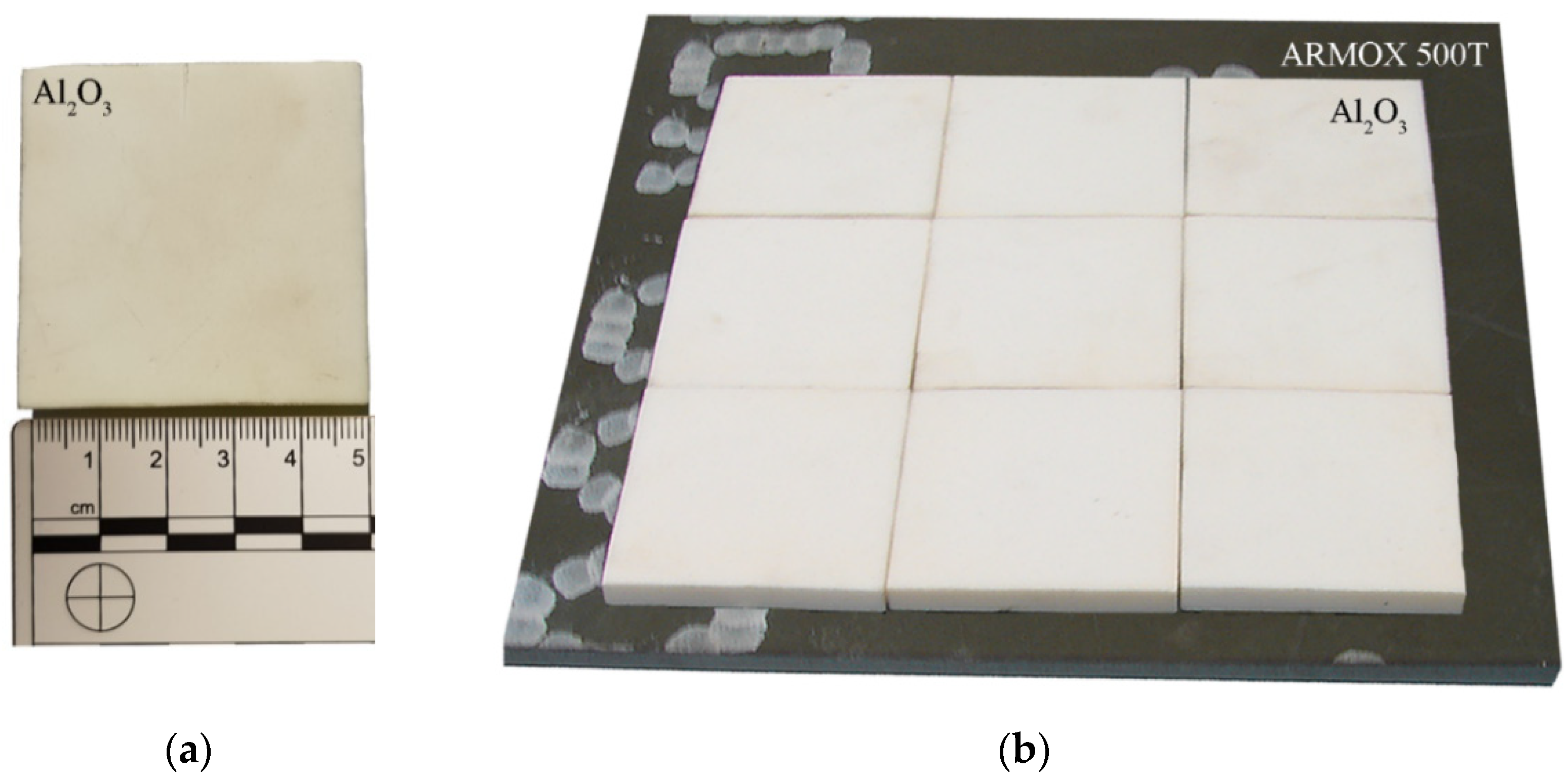
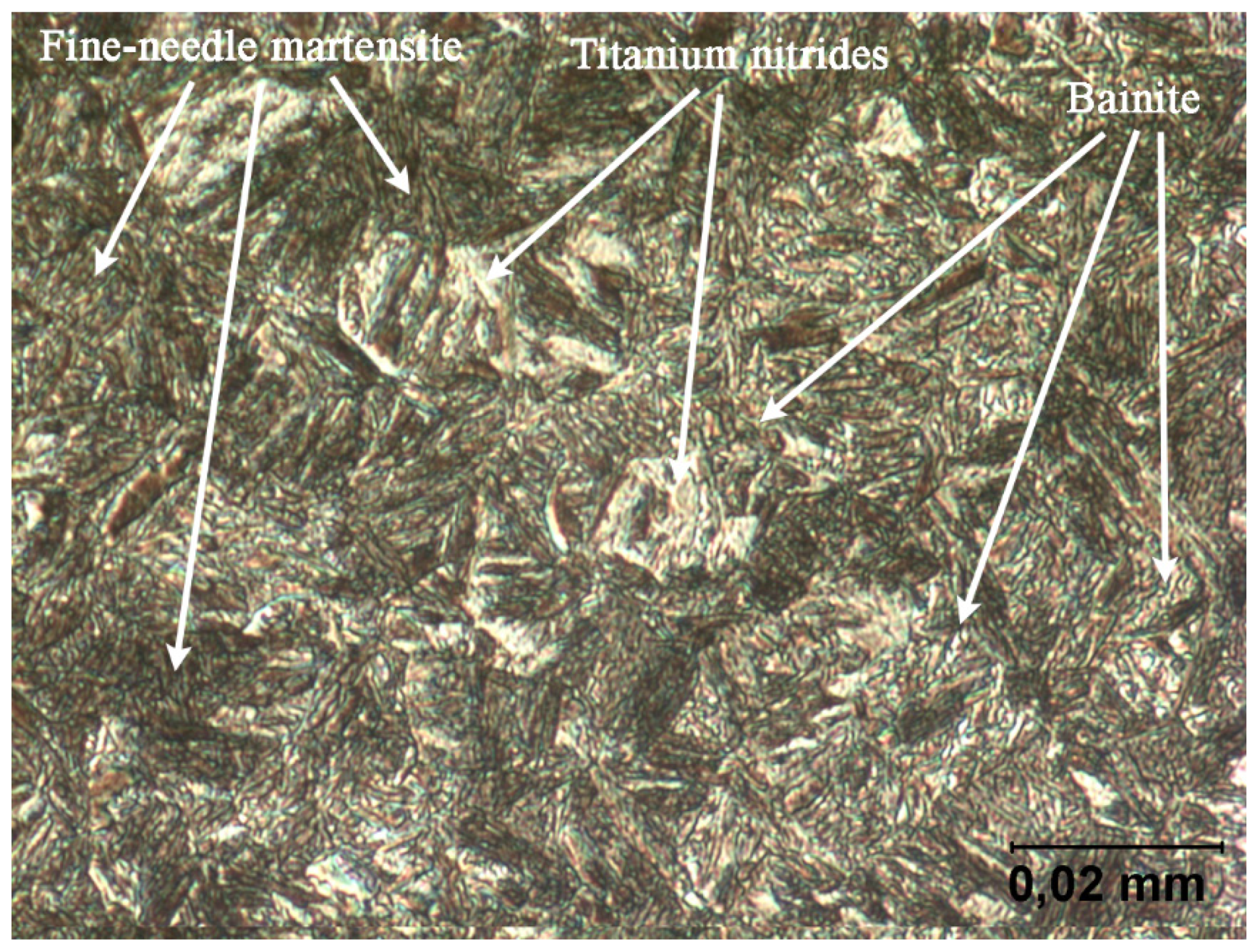
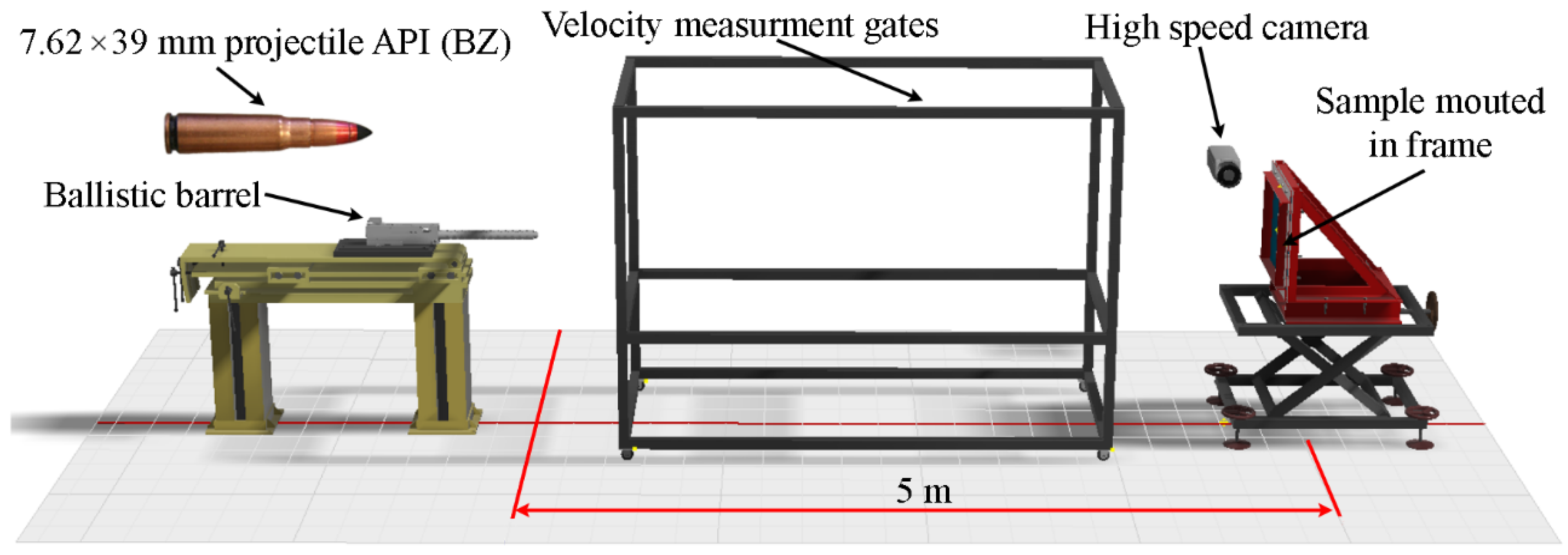




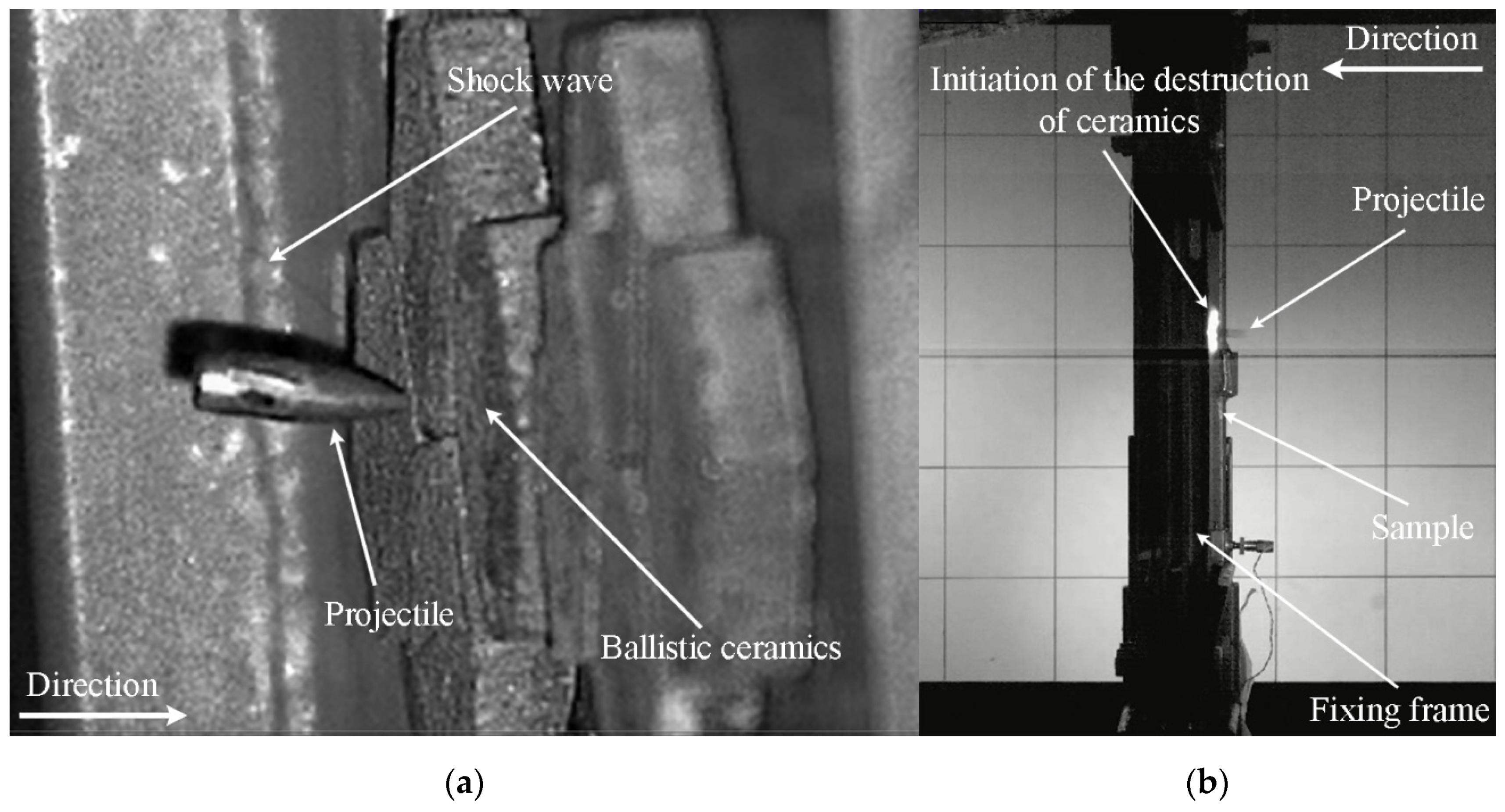

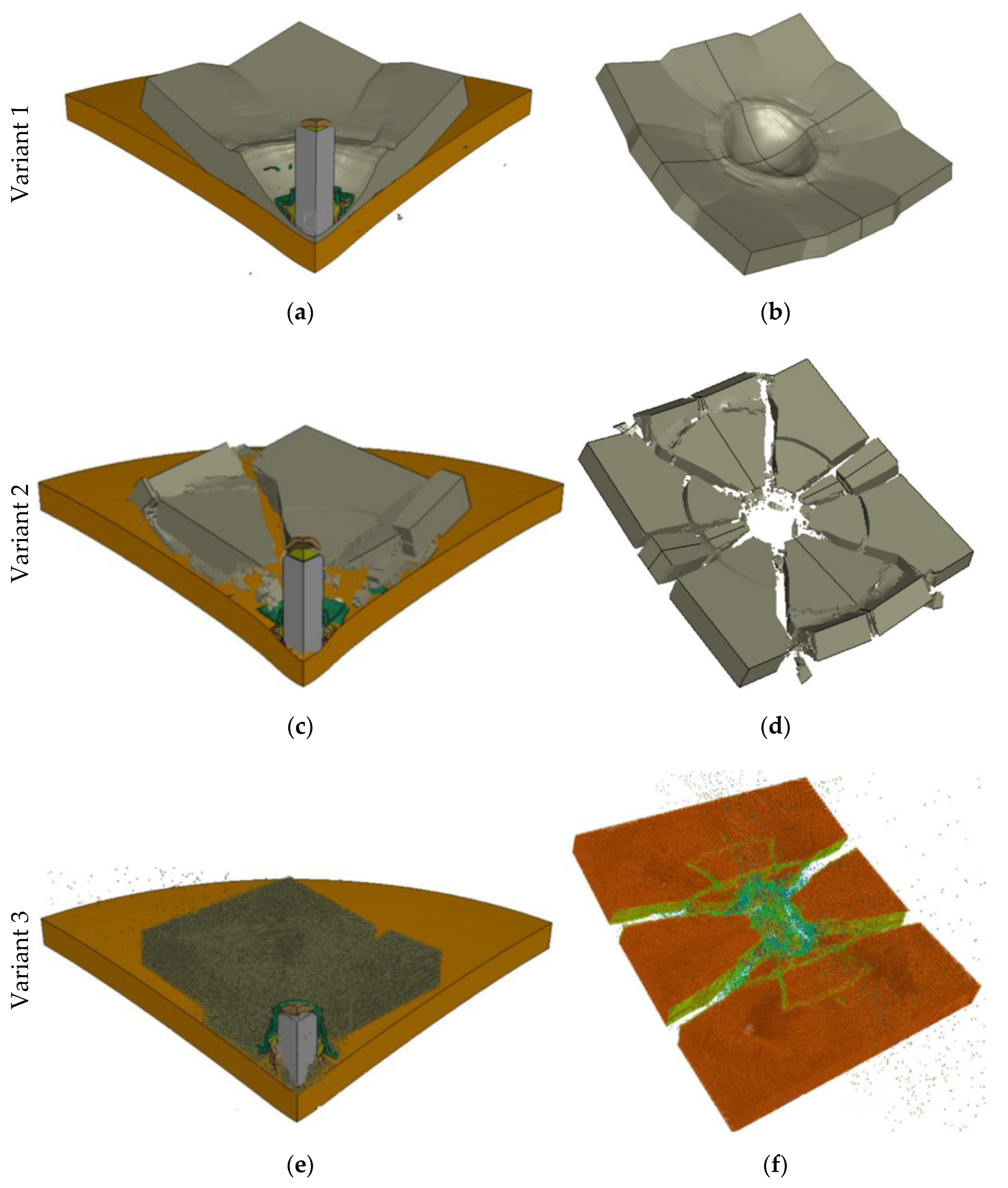
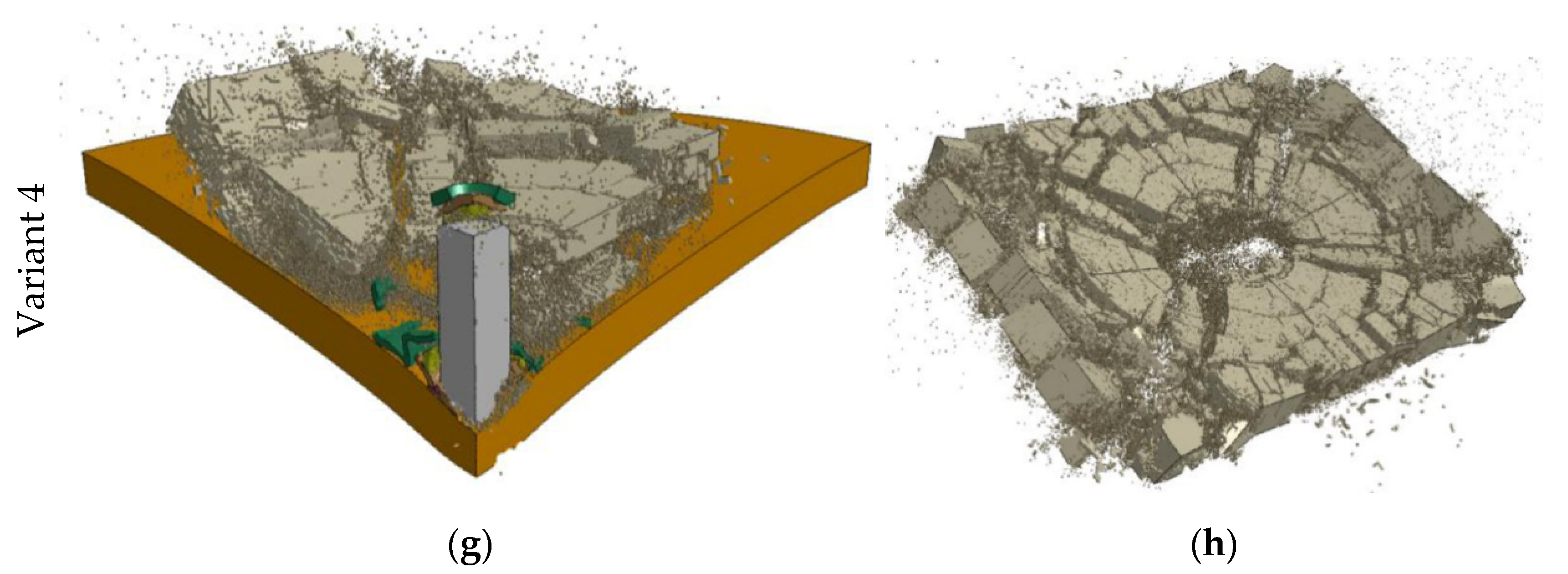
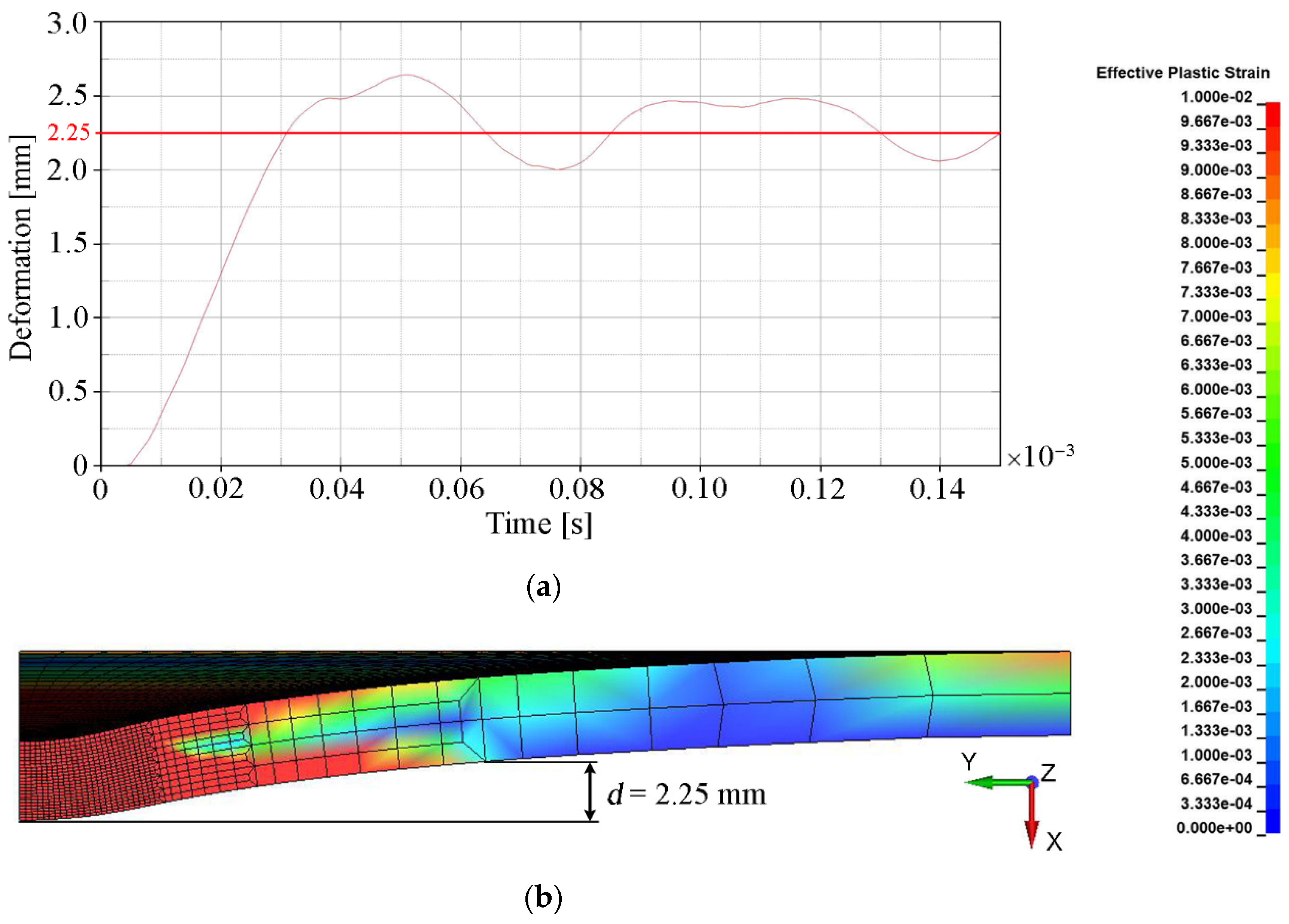
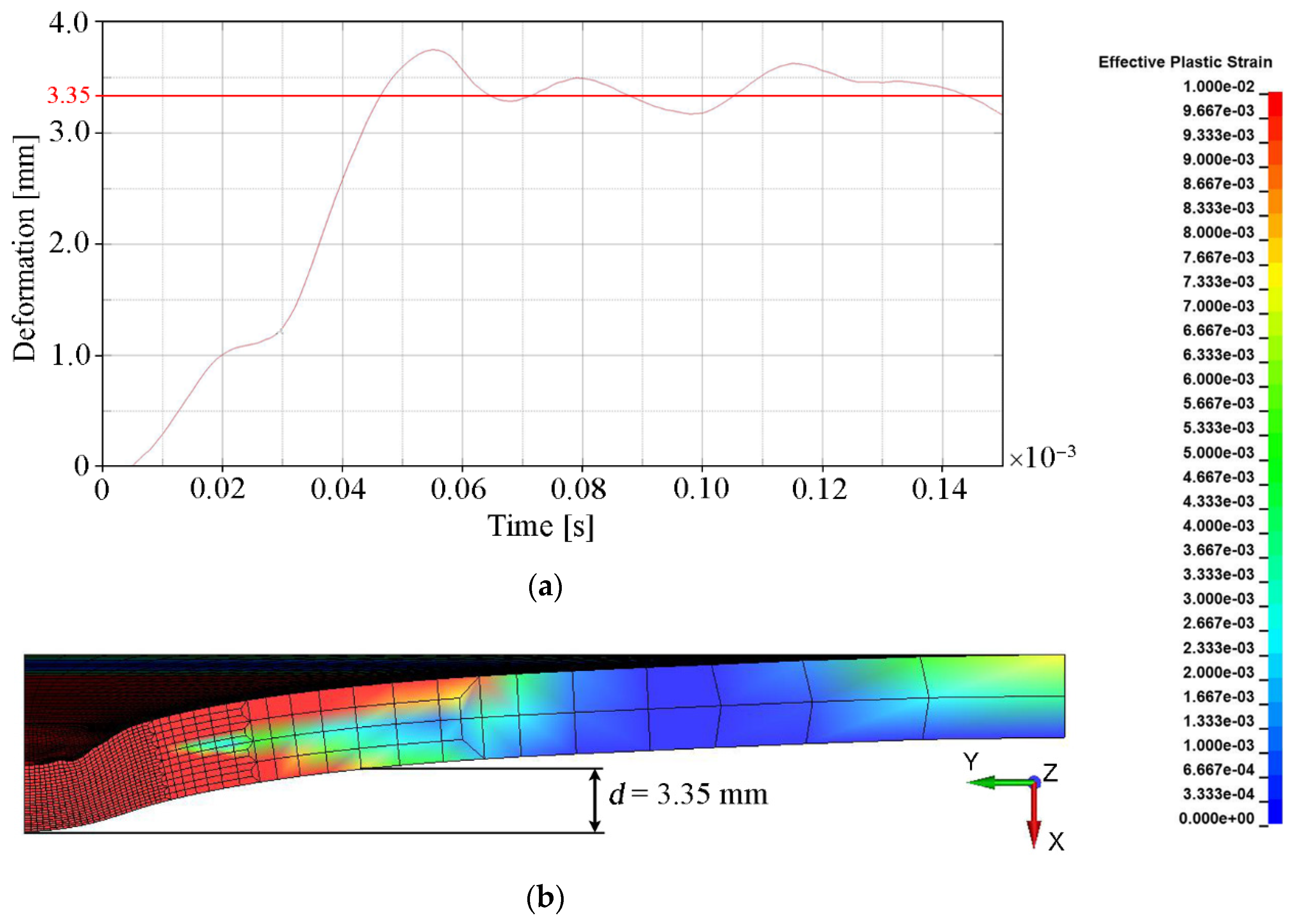
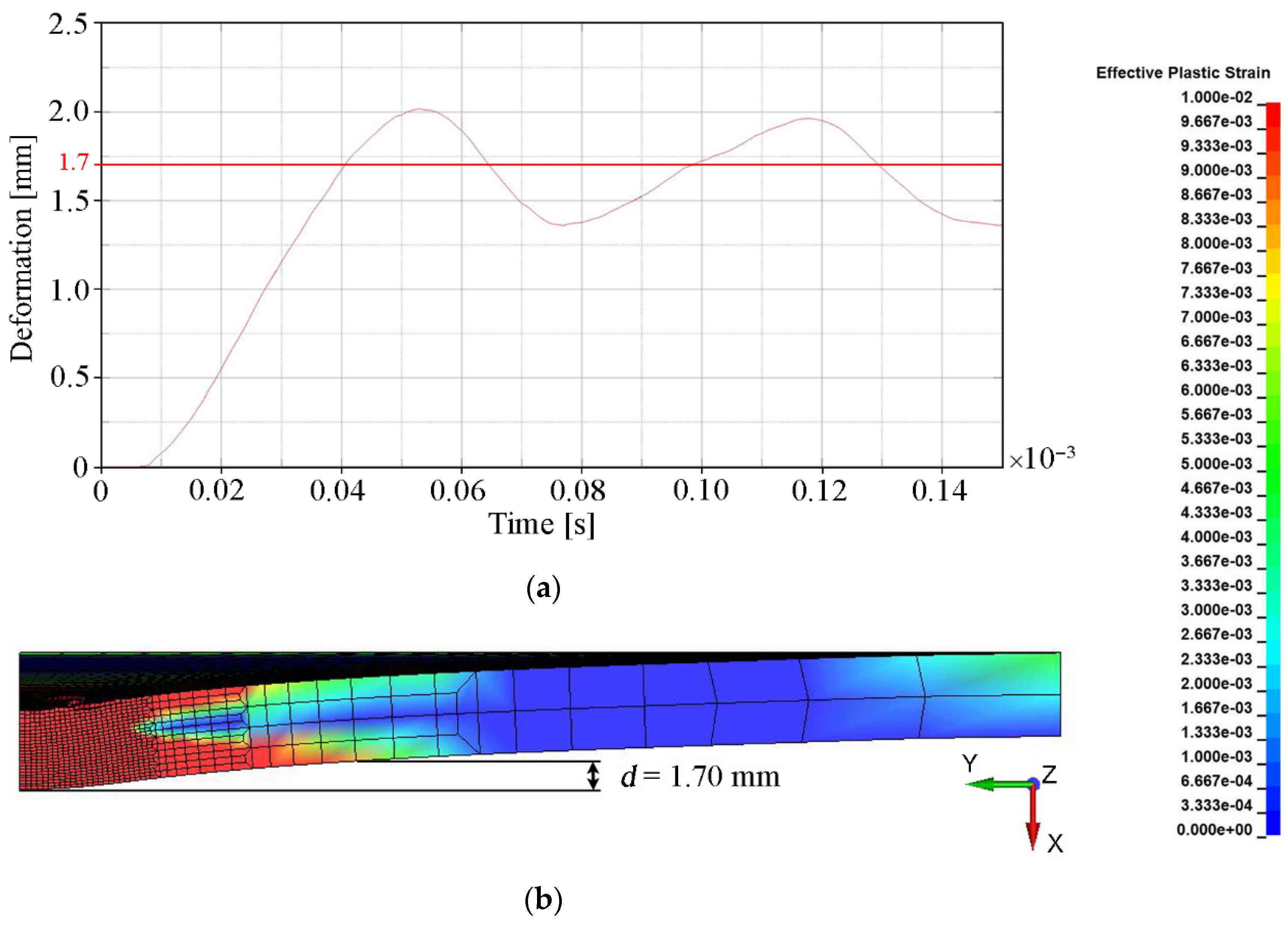
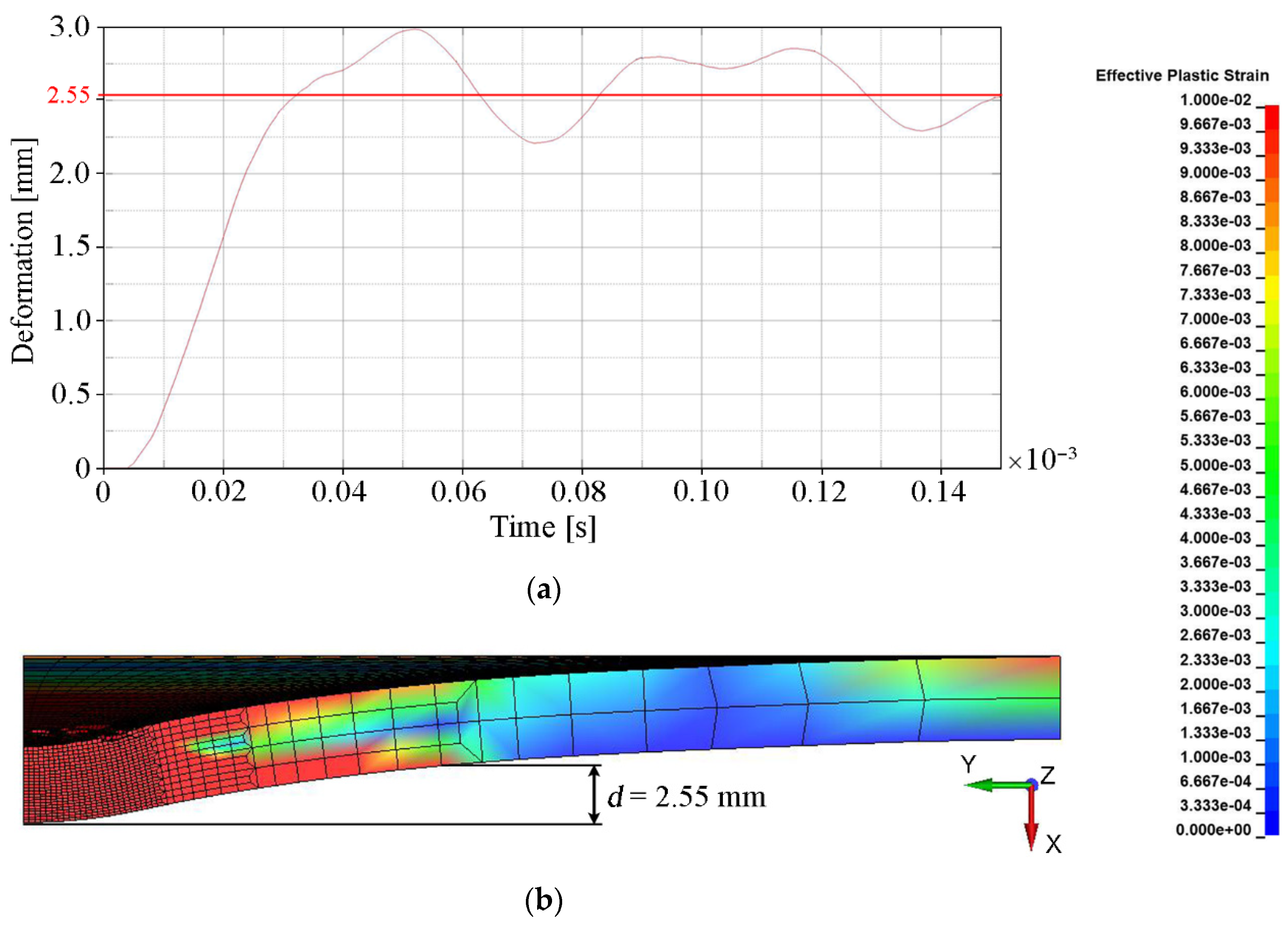



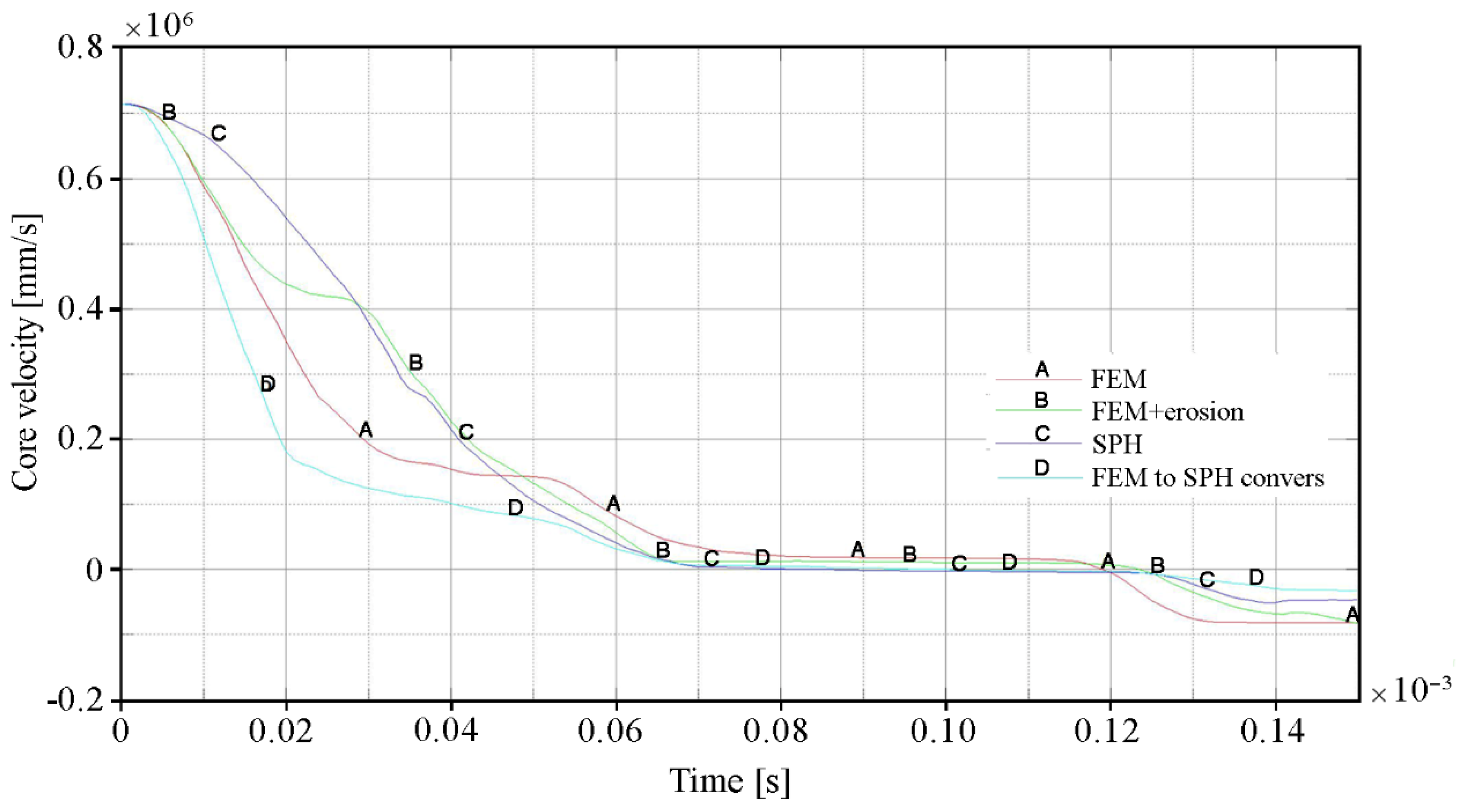
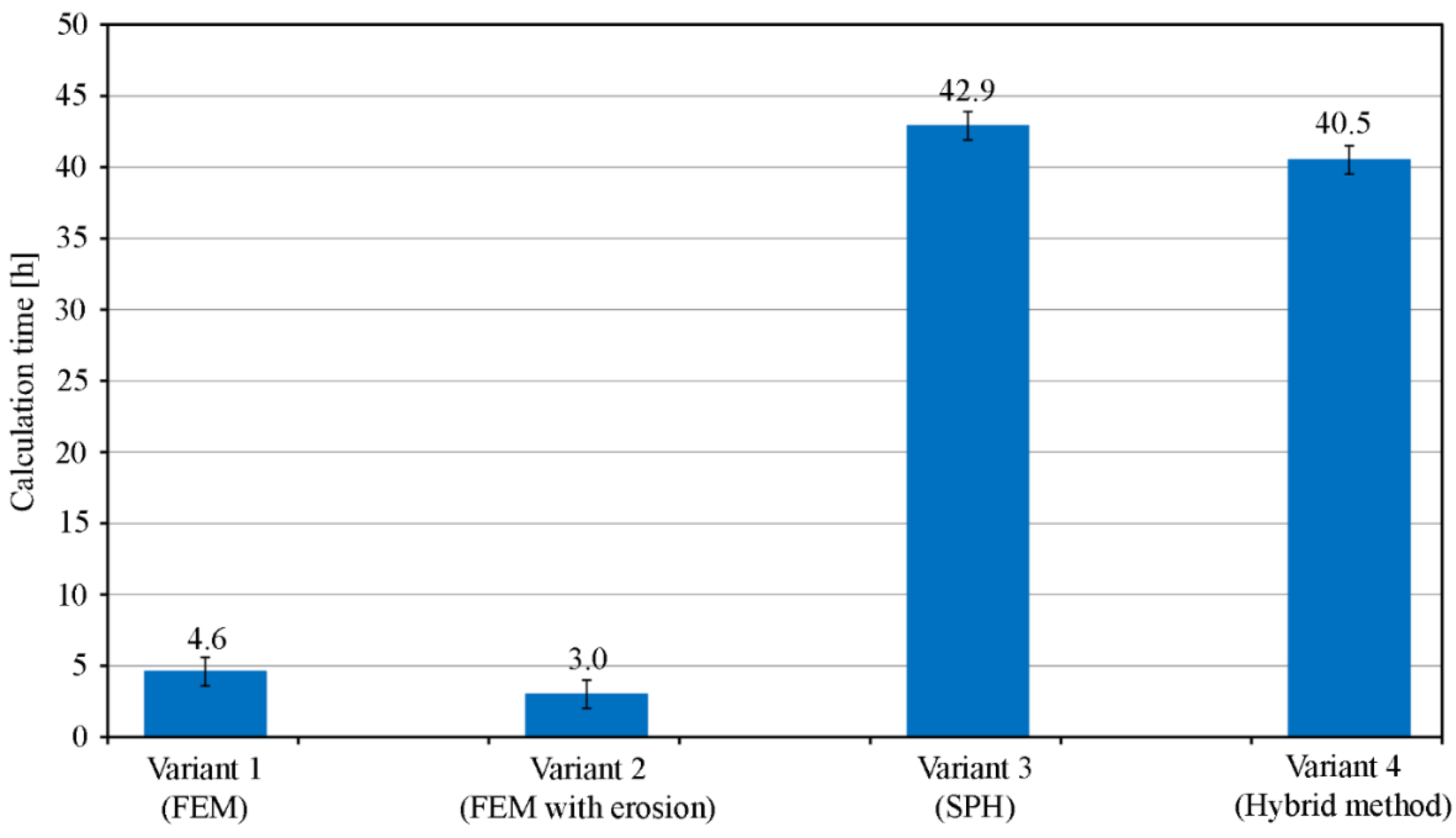
| Specification | Density, ρ [g/cm3] | Young’s Molus, E [GPa] | Tensile Strength, Rm [MPa] | Knopp Harness, HK [GPa] | Melting Point, Tt [K] | Ballistic Resistance, [K/kg × 103] |
|---|---|---|---|---|---|---|
| Al2O3 | 3.9 | 390 | 370 | 18 | 2320 | 1.5 |
| SiC | 3.1 | 410 | 200 | 21 | 3300 | 1.8 |
| B4C | 2.5 | 450 | 300 | 30 | 3300 | 5.3 |
| TiB4 | 4.5 | 570 | 350 | 33 | 3230 | 5.0 |
| RHA | 7.8 | 210 | 1000 | 3.5 | 1950 | 0.5 |
| Specification | Yield Strength, Rp0.2 [MPa] | Tensile Strength, Rm [MPa] | Hardness, HBW | Elongation, A5 [%] | Charpy-V, KCV−40 °C [J/cm2] | Charpy-V, KCV+20 °C [J/cm2] | ||||||||
|---|---|---|---|---|---|---|---|---|---|---|---|---|---|---|
| A500T * | 1442 | 1625 | 512 | 13 | 104 | 185 | ||||||||
| A500T | 1240 | 1450–1750 | 480–540 | min. 8 | min. 32 | - | ||||||||
| Chemical Composition [%] | ||||||||||||||
| C | Mn | Si | P | S | Cr | Ni | Mo | B | ||||||
| 0.280 * | 0.860 * | 0.260 * | 0.006 * | 0.001 * | 0.500 * | 0.870 * | 0.352 * | 0.002 * | ||||||
| 0.320 | 1.200 | 0.400 | 0.010 | 0.003 | 1.000 | 1.800 | 0.700 | 0.005 | ||||||
| Parameter | Hardened Core | Tombac Jacket | Steel Jacket | Lead Jacket | Incendiary Mass | Armox 500T Plate |
|---|---|---|---|---|---|---|
| ρ [g/cm3] | 7.85 | 8.96 | 7.85 | 11.34 | 2.00 | 7.85 |
| E [GPa] | 210 | 124 | 210 | 16 | 6 | 210 |
| v [-] | 0.33 | 0.34 | 0.33 | 0.42 | 0.30 | 0.33 |
| Cp [J/kgK] | - | 3850 | 4770 | - | - | 4770 |
| Tm [K] | - | 1356 | 1800 | - | - | 1800 |
| Strength model | *MAT_098 | *MAT_107 | *MAT_107 | *MAT_098 | *MAT_098 | *MAT_107 |
| A [MPa] | 1976 | 206 | 448 | 24 | 78 | 1580 |
| B [MPa] | 2856 | 505 | 303 | 300 | 160 | 756 |
| n [-] | 0.207 | 0.310 | 0.150 | 1.000 | 1.000 | 0.199 |
| C [-] | 0.005 | 0.025 | 0.003 | 0.100 | 0.0 | 0.005 |
| m [-] | - | 1.09 | 1.03 | - | - | 0.81 |
| Failure Model J–C | ||||||
| D1 | - | 0.540 | 0.540 | - | - | 0.068 |
| D2 | - | 4.88 | 4.88 | - | - | 5.32 |
| D3 | - | −3.03 | −3.03 | - | - | −2.55 |
| D4 | - | 0.014 | 0.014 | - | - | 0.016 |
| D5 | - | 1.12 | 1.12 | - | - | 1.10 |
| *MAT_ADD EROSION | MNPRES = −2600 EPSSH = 1 VOLEPS = 0.05 | VOLEPS = 0.2 EPSSH = 1 | VOLEPS = 0.2 EPSSH = 1 | VOLEPS = 0.5 EPSSH = 1 | VOLEPS = 0.01 EPSSH = 1 | EPSSH = 1 |
| Parameter | Al2O3 |
|---|---|
| ρ [g/cm3] | 3.84 |
| G [GPa] | 93 |
| A [-] | 0.93 |
| B [-] | 0.31 |
| C [-] | 0.007 |
| m [-] | 0.6 |
| n [-] | 0.64 |
| EPSI | 1 |
| T [MPa] | 262 |
| SFMAX | 1 |
| HEL [MPa] | 8000 |
| PHEL [MPa] | 1460 |
| Beta | 1 |
| D1 [-] | 0.01 |
| D2 [-] | 0.7 |
| K1 [GPa] | 131 |
| K2 [GPa] | 0 |
| K3 [GPa] | 0 |
| *MAT_ADD_EROSION | VOLEPS 0.05 |
| Shots No. | Projectile Velocity [m/s] | Penetrations/ None | Deformations [mm] | Remarks |
|---|---|---|---|---|
| 1 | 703.6 | None | 2.5 | |
| 2 | 699.4 | None | 2.0 | |
| 3 | 708.3 | None | 2.5 | |
| 4 | 712.1 | None | 3.0 | Little crack on the rear side of backing plate |
| 5 | 703.4 | None | 2.5 |
| Parameter | Experiment | Variant 1 (FEM) | Variant 2 (FEM + Erosion) | Variant 3 (SPH) | Variant 4 (FEM to SPH Conversion) |
|---|---|---|---|---|---|
| Ceramic tile fragmentation intensity | High intensity (large number of small fragments) | No fragmentation No correlation | Low Intensity Acceptable correlation | Low Intensity Acceptable correlation | High Intensity Very strong correlation |
| Backing plate deformation [mm] | 2.5 mm | 2.25 mm Error Δ = 11% Acceptable correlation | 3.35 mm Error Δ = 34% Weak correlation | 1.70 mm Error Δ = 32% Weak correlation | 2.55 mm Error Δ = 2% Very strong correlation |
Publisher’s Note: MDPI stays neutral with regard to jurisdictional claims in published maps and institutional affiliations. |
© 2021 by the authors. Licensee MDPI, Basel, Switzerland. This article is an open access article distributed under the terms and conditions of the Creative Commons Attribution (CC BY) license (https://creativecommons.org/licenses/by/4.0/).
Share and Cite
Zochowski, P.; Bajkowski, M.; Grygoruk, R.; Magier, M.; Burian, W.; Pyka, D.; Bocian, M.; Jamroziak, K. Comparison of Numerical Simulation Techniques of Ballistic Ceramics under Projectile Impact Conditions. Materials 2022, 15, 18. https://doi.org/10.3390/ma15010018
Zochowski P, Bajkowski M, Grygoruk R, Magier M, Burian W, Pyka D, Bocian M, Jamroziak K. Comparison of Numerical Simulation Techniques of Ballistic Ceramics under Projectile Impact Conditions. Materials. 2022; 15(1):18. https://doi.org/10.3390/ma15010018
Chicago/Turabian StyleZochowski, Pawel, Marcin Bajkowski, Roman Grygoruk, Mariusz Magier, Wojciech Burian, Dariusz Pyka, Miroslaw Bocian, and Krzysztof Jamroziak. 2022. "Comparison of Numerical Simulation Techniques of Ballistic Ceramics under Projectile Impact Conditions" Materials 15, no. 1: 18. https://doi.org/10.3390/ma15010018
APA StyleZochowski, P., Bajkowski, M., Grygoruk, R., Magier, M., Burian, W., Pyka, D., Bocian, M., & Jamroziak, K. (2022). Comparison of Numerical Simulation Techniques of Ballistic Ceramics under Projectile Impact Conditions. Materials, 15(1), 18. https://doi.org/10.3390/ma15010018










